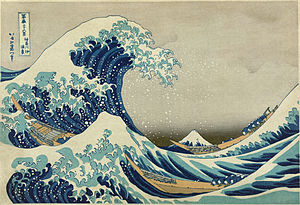
I was hearing about the famous painting, The Great Wave of Kanagawa, by Hokusai. It captures something of the horror of what’s fallen northern Japan, with its image of the fishermen dwarfed by the majestic, indifferent tower of water.
It’s a religious image, representing the very different approach that Shintoism has towards nature, compared with Christianity. In Christianity, human beings are at the centre of nature: creation is for humanity, along with other creatures, and it’s humanity’s task to care for it. Hence, in part, the offence we feel when nature turns against us.
In Shintoism, nature is recognised as infinitely more powerful than humankind – as in the wave – and that humankind is in nature with the permission of the gods but with no particular concern from the gods. Shinto rituals show respect for the gods of nature, befriending the enormity of the forces, if you like. But, apparently, there won’t be much of the moral affront at what’s happened – the problem of evil – from the Japanese perspective.